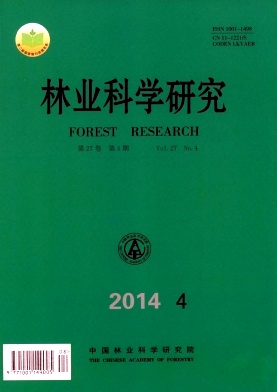|
[1]
|
罗天祥. 中国主要森林类型生物生产力格局及其数学模型[D]. 北京:中国科学院研究生院(国家计划委员会自然资源综合考察委员会),1996
|
|
[2]
|
朴世龙,方精云,郭庆华. 1982-1999年我国植被净第一性生产力及其时空变化[J]. 北京大学学报:自然科学版,2001,37(4): 563-569
|
|
[3]
|
Dixon R K, Brown S, Houghton R A, et al. Carbon pools and flux of global forest ecosystems[J]. Science, 1994, 263(5144): 185-190 |
|
[4]
|
方精云,陈安平,赵淑清,等. 中国森林生物量的估算:对Fang等Science一文(Science,2001,291:2320-2322)的若干说明[J]. 植物生态学报,2002,26(2): 243-249
|
|
[5]
|
Brown S L, Schroeder P, Kern J S. Spatial distribution of biomass in forests of the eastern USA [J]. Forest Ecology and Management, 1999, 123(1): 81-90 |
|
[6]
|
Kauppi P E, Mielikinen K, Kuusela K. Biomass and carbon budget of European forests, 1971 to 1990[J]. Science,1992, 256(5053): 70-74 |
|
[7]
|
Field C B, Behrenfeld M J, Randerson J T, et al. Primary production of the biosphere: integrating terrestrial and oceanic components[J]. Science, 1998, 281(5374): 237-240 |
|
[8]
|
冯宗炜,王效科,吴 刚. 中国森林生态系统的生物量和生产力[M]. 北京: 科学出版社,1999
|
|
[9]
|
Rosswall T. The international geosphere-biosphere programme: a study of global change (IGBP)[J]. Environmental Geology, 1992, 20(2): 77-78 |
|
[10]
|
IGBP. The terrestrial carbon cycle: implications for the Kyoto Protocol [J]. Science, 1998, 280(5368): 1393-1394 |
|
[11]
|
Cramer W, Kicklighter D W, Bondeau A, et al. Comparing global models of terrestrial net primary productivity(NPP):overview and key results[J]. Global Change Biology,1999,5(1):1215 |
|
[12]
|
刘 磊. 基于多源数据的森林生物量与生产力估算研究[D]. 南京: 南京林业大学,2010
|
|
[13]
|
赵士洞,罗天祥. 区域尺度陆地生态系统生物生产力研究方法[J]. 资源科学,1998,20(1): 25-36
|
|
[14]
|
张冬有,冯仲科,李亦秋,等. 基于C-FIX模型的黑龙江省森林植被净初级生产力遥感估算[J]. 林业科学,2011,47(7):13-19
|
|
[15]
|
董 丹,倪 健. 利用CASA模型模拟西南喀斯特植被净第一性生产力[J]. 生态学报,2011,31(7): 1855-1866
|
|
[16]
|
高清竹,万运帆,李玉娥,等. 基于CASA模型的藏北地区草地植被净第一性生产力及其时空格局[J]. 应用生态学报,2007,18(11): 2526-2532
|
|
[17]
|
王 萍. 基于IBIS模型的东北森林净第一性生产力模拟[J]. 生态学报,2009,29(6):3213-3220
|
|
[18]
|
黄晓云,林德根,王静爱,等. 气候变化背景下中国南方喀斯特地区NPP时空变化[J]. 林业科学,2013,49(5):10-16
|
|
[19]
|
王 斌,刘某承,张 彪. 基于森林资源清查资料的森林植被净生产量及其动态变化研究[J]. 林业资源管理,2009,1(3): 35-43
|
|
[20]
|
Zhao M, Zhou G S. A New Methodology for Estimating NPP of Forest from Forest Inventory Data: A Case Study [J].Journal of Forestry Research, 2004, 15(2): 93-100 |
|
[21]
|
王玉辉,周广胜,蒋延玲,等. 基于森林资源清查资料的落叶松林生物量和净生长量估算模式[J]. 植物生态学报,2001,25(4): 420-425
|
|
[22]
|
李文华. 森林生物生产力的概念极其研究的基本途径[J]. 自然资源,1978(1):71-92
|
|
[23]
|
张宪洲. 我国自然植被净第一性生产力的估算与分布[J]. 自然资源,1993(1): 15-21
|
|
[24]
|
方精云,刘国华,徐嵩龄. 我国森林植被的生物量和净生产量[J]. 生态学报,1996,16(5):497-508
|
|
[25]
|
Zhou G S, Wang Y H, Jiang Y L, et al. Estimating biomass and net primary production from forest inventory data: a case study of China's Larix forests [J]. Forest Ecology and Management, 2002, 169(1): 149-157 |
|
[26]
|
Zhao M, Zhou G S. Estimation biomass and NPP of major planted forests based on forest inventory data in China [J]. Forest Ecology and Management, 2005, 207(3):295-313 |
|
[27]
|
Wang B, Huang J, Yang X, et al. Estimation of biomass, net primary production and net ecosystem production of China's forests based on the 1999-2003 National Forest Inventory[J]. Scandinavian Journal of Forest Research, 2010, 25(6): 544-553 |
|
[28]
|
汪业勖,赵士洞,牛 栋. 陆地土壤碳循环的研究动态[J]. 生态学杂志,1999,18(5):29-35
|
|
[29]
|
吴庆标,王效科,段晓男. 中国森林生态系统植被固碳现状和潜力[J]. 生态学报,2008,28(2): 517-514
|
|
[30]
|
肖兴威. 中国森林生物量与生产力的研究[D]. 哈尔滨: 东北林业大学, 2005
|
|
[31]
|
Tomppo, E. Nilsson M. Rosengern M, et al.Simultaneous use of Landsst TM and IRS-IC WIFS data in estimating large area tree stem volume and aboveground biomass[J]. Remote Sensing of Environment, 2002,82(1): 156-171 |
|
[32]
|
高艳妮,于贵瑞,张 黎,等. 中国陆地生态系统净初级生产力变化特征——基于过程模型和遥感模型的评估结果[J]. 地理科学进展,2012,31(1): 109-117
|
|
[33]
|
顾 娟, 李 新, 黄春林,等. 2002-2010 年中国陆域植被净初级生产力模拟[J]. 兰州大学学报: 自然科学版, 2013, 49(2): 203-213
|
|
[34]
|
陈利军,刘高焕,励惠国. 中国植被净第一性生产力遥感动态监测[J]. 遥感学报,2002,6(2):129-135
|
|
[35]
|
朴世龙, 方精云, 郭庆华. 利用 CASA 模型估算我国植被净第一性生产力[J]. 植物生态学报,2001,25(5):603-608
|
|
[36]
|
Whittaker R H,Likens G E.Carbon in the biota[C]//Woodwell G M,Pecan E V. Carbon and the biosphere .Virginia:Springfield, 1973:281-302 |
|
[37]
|
刘世荣,徐德应,王 兵. 气候变化对中国森林生产力的影响 Ⅰ.中国森林现实生产力的特征及地理分布格局[J]. 林业科学研究,1993,6(6):635-641
|





 DownLoad:
DownLoad: